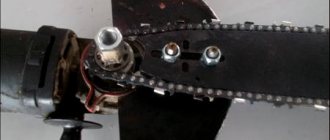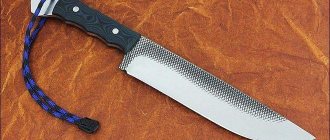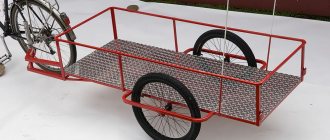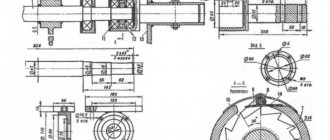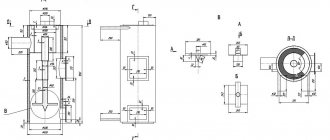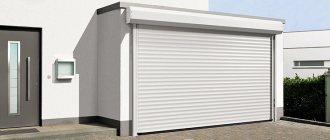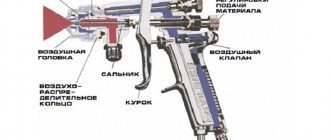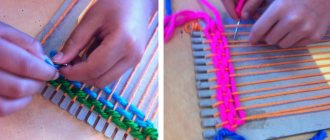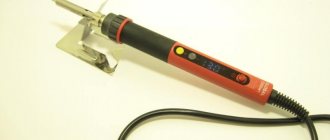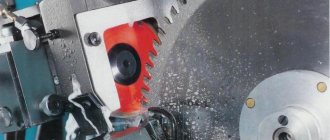How to choose the right machine for sharpening chainsaw chains?
A chainsaw chain sharpening machine is a unique piece of equipment that can tidy up the chain of a woodworking tool in a matter of minutes, which means significantly extending its service life.
Sharpening machine for chainsaw chains
Modern models of such devices allow you to process several chainsaws at once in a short time. They are most in demand in the timber industry, as well as in the construction and finishing of wooden houses. Currently, there are a huge number of such devices on sale, suitable for both home and industrial use.
Homemade device for sharpening chainsaw chains
Making a machine for sharpening chainsaw chains with your own hands is no more difficult than assembling a homemade grinder or band sawmill. However, such homemade products are less popular. This is probably due to their narrow specialization, as well as the presence of many alternative options using fairly simple devices that allow you to sharpen a chain with the same quality and in almost the same time. Most often, homemade machines for sharpening saw chains are designed by those who live “on the ground”, far from cities, and often use a chainsaw both for collecting firewood and for home construction.
The initial stage of repair and restoration work
All known methods of shortening a saw chain require criteria for the rejection of damaged cutting and connecting links and a technology-defined sequence of work operations. The cutting and connecting links are mounted with factory rivets, which in all respects comply with current standards.
The use of homemade components is not recommended in any case. Special rivets for chains are extremely rare on sale, so in most cases the problem is solved by installing the necessary parts removed from the dismantled section of the chain.
The device of a machine for sharpening saw chains
The sharpening machine is designed for alternately sharpening the teeth of electric and chain saw chains using a rotating abrasive wheel. In this case, the linear and angular dimensions of the cutting surfaces of all teeth must be absolutely identical. If the sharpening is uneven, then when sawing there is an additional load on the chain, vibration appears, and the chainsaw bar may be pulled to the side. Therefore, the working mechanisms and structural elements of the machine must withstand the specified chain sharpening parameters with high accuracy and stability.
Some theoretical information
The main geometric characteristics of the chain cutting tooth:
- cutting edge angle (A);
- sharpening angle (B);
- front surface profile (C).
On saw chain machines, the sharpening angle is set by turning the chain locking device to a predetermined angle (30º for most). On factory machines, a graduated scale is used for this. Homemade ones are usually set using a protractor, a template, or simply a new chain. The angle of the cutting edge is set by the inclination of the abrasive disc. To achieve this, all machines have a sharpening head mounted on a rotary joint. For factory products, this angle is set in degrees on a scale. On homemade machines, they use a fairly simple method: they adjust the inclination of the sharpening disk to a tooth with normal geometry, and then fix the head with a screw clamp.
The profile of the front surface of the tooth follows the contour of the end of the abrasive wheel, which is initially slightly rounded for specialized discs. On homemade machines, they use various sharpening discs, up to grinder wheels, the cutting edges of which also take on a rounded shape in the process (albeit not entirely standard).
An important point when creating a homemade chain sharpening machine is the choice of the diameter of the grinding wheel. It must correspond to the rotation speed of the electric motor, since the linear speed of the abrasive depends on this. If it is significantly exceeded, the steel of the tooth can be heated and released in a few seconds, and if the values are too low, the sharpening speed will noticeably slow down.
To sharpen chains, a motor power of 80÷100 W is sufficient. Many factory products from reputable manufacturers (for example, Oregon and Sadko) have 85 W motors at 5000–6000 rpm. Most often, the diameter of the grinding disk on such machines is 100 or 104 mm, which corresponds to a linear speed of 26–30 m/sec.
Homemade machines often use electric motors from old washing machines with a power of 180 W and a rotation speed of 3000 rpm. In this case, chain sharpening wheels with a diameter of 145 mm are suitable.
Design and main components
Homemade machines for sharpening saw chains usually copy the design and technical solutions of factory products. This can be called the use of standard solutions, since most factory machines are similar to each other and consist of the same functional units:
- support frame;
- Rotary table;
- chain guide;
- tilting sharpening head;
- hinged connection between the frame and the head.
In homemade machines, the bed is made from a thick strip or metal profile, often using pieces of angle or channel found in scrap metal. Various devices with an axis and a screw lock act as rotary tables. As a rule, they do not have any scale, and the sharpening angle is set once using a new chain.
The design of the guides is approximately the same for all: two metal plates 2÷3 mm thick in the shape of a chainsaw bar, fastened together with three or four screws. They are separated from each other by washers, the thickness of which is slightly greater than the transverse dimension of the guide tooth. The folding stop and chain clamping device are usually similar to those used on factory machines. The hinge of the sharpening head and the device for its rotation are very diverse, since they are made from improvised means, most often from parts from old automobile and agricultural machinery.
Setting the angle of the sharpening disk is usually done not according to a scale (which, as a rule, does not exist), but according to the actual angle of the cutting tooth of the chain. To do this, the abrasive wheel is brought to the edge of the tooth, carefully selecting the slope so that the edge of the wheel fits tightly to the edge of the disk. After this, fix the head with a locking screw and install a sharpening depth limiter, which is a regular screw with a stop plate.
Many home craftsmen do not use such limiters, although working without them requires greater concentration.
Motors, handles, rear disc casings and return springs of grinding heads on homemade machines are very diverse, because they are selected from available parts and then adapted to the design of the machine. Some craftsmen do not use handles at all, tilting the head directly behind the motor housing.
WARNING Unsafe! Endless line for TRIMMER. Experience
How to Choose a Handheld Circular Saw for the Home
Good hand-held circular saw. How to Choose a Circular Saw: Tips and Tricks Previously, only the circular saw was seen in sawmills. Today, many private craftsmen are thinking about which model of such equipment to choose. If you also decide to purchase such a device, it is important to consider the main characteristics, including, for example, the power supply. Business date, meeting Most saws are powered from the mains, [...]
Circular saw Whirlwind DP 160
Review: Hand-held circular saw Vortex DP-160/1300. Good household saw This saw is essentially the second one, I left the first one about the first one (this is Zubr ZPD-186-1600 https://otzovik.com/review_3382949.html), but I used this one for the first time. I liked this drink. Comfortable main handle (the handle itself, together with the additional one, is not an integral part of the engine body), rubberized, the rubber layer is not superficial (as […]
Bulgarian. The main system of such a device is a bearing assembly with a shaft. A driven pulley is installed at one end of it, which rotates via a V-belt. A mandrel for cutting wheels is attached to the other. Depending on their brand, such an angle grinder can of course cut stone, metal, brick and other building materials.
Ice drill. For good operation of the device, a high auger speed is not desirable, so you need to use a gearbox made in the form of a worm or V-belt drive. Such a device can be used for the construction of a foundation from helical piles and also for other earthworks.
Water pumps are used for watering the garden, emergency water supply, draining reservoirs, or flooded basements. This attachment is a regular centrifugal pump, equipped with a bracket for attaching to a saw and a pulley that drives the pump turbines.
A winch that uses a chainsaw drive. The traction force of such a device directly depends on the power of the saw motor. With the use of an additional block, of course, it can be significantly increased. This device is equipped with additional parts such as a tap block, hooks, belts, and anchors.
A boat motor made from a chainsaw is a good candidate for purchasing an expensive motor. To ensure movement of 20 km/h, it is enough to install on the boat a homemade outboard motor with a gearbox (gear ratio 2.4:1) and a 3-bladed propeller with a diameter of 210 mm. At the same time, fuel consumption will be only 1 liter per hour of engine operation.
Sources:
https://moy-instrument.ru/instrumenty/kak-pravilno-ustanovit-tsep-na-benzopilu-shtil.html https://samastroyka.ru/ustanovka-cepi-ot-benzopily-na-trimmer.html https: //krrot.net/cep-ot-benzopilu-na-trimmer/ https://mercabadom.ru/cep-ot-benzopily-na-trimmer-svoimi-rukami/
Making a stationary machine with your own hands
To make your own machine, you need to know the theoretical foundations of sharpening the teeth of saw chains and understand (at least in general terms) the design features and operating principle of such equipment. It is also very useful to look at ready-made and practice-tested models of folk craftsmen and be sure to listen to their comments. After all, they may contain tips for solving certain problems that will certainly arise during the development and manufacture of your sharpening machine.
For example, in the video below, attention is drawn to the original design of the return spring and the placement of the hinge directly on the horizontal part of the frame. In this design, movement of the chain is not very convenient, and starting the engine “by hand” does not stand up to criticism. This machine is a typical example of a sharpening device, completely assembled from scrap materials.
The author of the next video does not comment on it in any way, but writes on the forum that this is the third version of his homemade machine (the first two were unsuccessful) and that it was assembled entirely from scrap metal (water pipes and a corner). It uses a 500 watt motor with a rotation speed of 2700 rpm.
The following video presents the most “factory” version of a homemade machine for sharpening saw chains. Everything here is adjustable, as in factory products, the chain bar is located very conveniently, and the design itself looks quite professional - even the handles are equipped with large round knobs.
The main disadvantage of all these fully functional homemade devices is the complete or partial failure of their authors to comply with safety regulations. This mainly relates to the absence of a protective casing on the outside of the sharpening wheel. But this is not a reinforced circle for an angle grinder, but a rather fragile product made of corundum oxide with ceramic binders.
On all machines of this type, sharpening itself takes only a few seconds. And most of the time is spent moving the chain manually to the next tooth.
Are there machines with fast and fixed movement of the chain, for example, from a lever? After all, for this it is quite possible to use the driven sprocket of a chainsaw. If anyone has come across such solutions, please share information about it in the comments to this article.
Why does the tool become dull?
Each chainsaw has a certain durability period. This is the time from the start of work with a new tool until it becomes inoperable.
Destruction or wear of a cutting tool intended for woodworking occurs due to the impact of a set of forces arising during the cutting process. One of the key ones is friction force. Dulling of the saw chain occurs due to prolonged work, due to the use of a chainsaw for purposes other than its intended purpose.
The amount of wear can be defined as a measure of weight, measured in milligrams. Wear is a parameter that shows a change in the characteristics of the shape and size of the cutting blade. The change in geometric parameters that occurs during cutting, and there is no linear wear, is called blunting.
There are parameters on the basis of which a decision is made on the possibility of further operation of the tool
In particular, when examining the teeth of a saw chain, it is necessary to pay attention to the edges of the front and rear surfaces, the height of the blade, and the wear area. If they are in unsatisfactory condition, it means it’s time to sharpen the chainsaw.
Signs that the saw has lost its sharpness include the following:
- Reducing chip size.
- Using more force to do the job.
Do-it-yourself assembly of a machine for sharpening chainsaw chains - instructions and drawings
Is it possible to sharpen a chainsaw chain yourself? Despite the complex configuration of the cutting part, this process can be done at home. Sharpening can be done using a set of needle files, which will take a long time and will not always lead to the desired result. When constantly using a chainsaw, it is best to make a machine that provides the best quality and the required speed of performing this procedure.
Sharpening technology
The main cutting element of the chain is a specially shaped tooth. It removes wood chips in a similar way to a plane. But unlike it, the tooth has two sharpened edges that are at an angle relative to each other. One of them cuts in a horizontal plane, and the second in a vertical plane. In this case, the teeth are attached alternately to the right and left sides of the chain.
Before you start choosing the optimal machine design for sharpening chainsaw chains, you need to familiarize yourself with the recommendations and rules. The main one is compliance with the contact angles of the sharpening tool and the cutting part of the link.
- The rake angle formed by the end blade and the sliding surface of the link should be between 60 and 85°. The rear angle of the upper blade is from 50 to 60°. The sharpening angle of the upper cutting part is from 25 to 35°.
The last parameter is decisive when choosing a machine manufacturing scheme. Mandatory compliance with these dimensions imposes strict requirements on the design. You should also pay attention to the intensity of the impact of the sharpening tool on the cutting edge. It is unacceptable to change the configuration of the blades - increasing the cutting angle, decreasing its plane. The exception is reducing the height of the cut stop. This is only done when working with “clean” wood that is free of metal debris.
Manual method
Manual sharpening set
With a light chainsaw load, sharpening its chain can be done manually. To do this, you will need sets of needle files and a special template. It is best to purchase a kit that includes these elements.
To form a high-quality cutting edge, you will need to fix the chain. Therefore, it is recommended to secure the chainsaw bar in a vice. In this way, it is possible to ensure a clear position of each link. Having established the template, the tooth blade and end blade are sharpened using needle files.
However, this technology has a number of features that should be taken into account.
- The sets are designed for chains with a specific configuration – pitch 3/8” and link thickness 1.3 mm. Low sharpening speed. If the cutting part is significantly damaged, it is almost impossible to manually correct its configuration. Low cost of the set - from 600 rubles.
That is why, when working intensively, they prefer to use semi-automatic machines. They have greater productivity, and if the sharpening technology is followed, the quality of the result will always be superior to the manual method.
Electric machine
Is it advisable to make a chain sharpening machine yourself? Already at the stage of design and selection of components, you may encounter a problem - manufacturing a desktop. It is designed to fix the chain and adjust the link relative to the cutting edge of the sharpening disk.
Structurally, it consists of a platform on which a work table and an electric motor with an abrasive element are mounted. The position of the link is adjusted using a screw system. For greater accuracy, a graduated scale is installed on the top of the table.
Those. To make such a device with your own hands, you will need to make a frame, which is a labor-intensive and complex process. To do this, you will need to make all the components using a lathe, having previously calculated their exact dimensions. An alternative is to purchase a ready-made base. However, its cost differs slightly from the price of a factory machine for sharpening chainsaw chains.
The feasibility of self-repair
Experts advise riveting and repairing a damaged chain using the technical potential of a service workshop. Despite manufacturers' assurances about the problems and difficulties of self-repair, a significant portion of users prefer to learn techniques for restoring the functionality of saw sets on their own.
- the owner lives at a great distance from service and maintenance points;
- high cost of repair services provided;
- lack of necessary equipment.
Compensating for natural chain wear by shortening is neither advisable nor safe. Operating a saw set with a stretched chain is inevitably accompanied by:
- forced wear of the tire and drive sprocket;
- increased load on the engine;
- increased risk of injury from sawing work of various levels of complexity.
Sharpening a chainsaw chain with your own hands. Sharpening methods and types of machines
For work in the garden, one of the indispensable tools is a chain saw - electric or powered by a gasoline engine. Like any other tool, the saw needs care and maintenance of the working element - the cutting chain.
Blunt chain teeth not only impair the quality of the cut and lead to wear on the mechanisms, but also increase the risk of injury. The complex geometric shape of the cutting edge instills uncertainty in the owner of the saw when it comes time to sharpen the chainsaw chain. In fact, the process is not very complicated - you just need to have an understanding of the structure of a saw edge, a regular set of files and a little experience.
Advice from professionals
The new chain must be run in so that the mating parts get used to it. At low speeds for a minute, the lubricant will fill the channels on the tire.
Particular attention should be paid to chain tension. Weak tension leads to collapse and the load increases, which can lead to link rupture.
Monitor the level of oil intended for lubrication of the chain, bar, and sprockets. The lack of lubricant leads to increased wear of the chainsaw elements.
After work, clean and generously lubricate the chain with clean oil.
Cutting edge structure
1 – link base; 2 – upper edge of the tooth blade; 3 – cut depth limiter; 4 – side cutting edge; 5 – working angle of the upper blade.
The teeth of the chain have two cutting surfaces - top and side, and the first of them is inclined relative to the line of movement of the chain. A chain saw works on the principle of a plane - the tooth planes the wood, and the limiter regulates the thickness of the chips:
Dull teeth cause the saw to crush the wood instead of cutting it. The teeth react especially quickly to contact with the soil - once or twice you hit the ground, the saw needs to be sharpened.
View of the tooth after contact with rocky soil
The process of sharpening a chainsaw chain with your own hands involves removing a layer of metal from the teeth, therefore, frequent adjustments help reduce the amount of material removed.
When should you sharpen your saw?
The first sign that the blade needs to be checked is increased feed. A good chain fits into the wood even with just a little pressure. The second signal is a decrease in chip thickness.
Proper sharpening of a chainsaw chain with your own hands involves maintaining optimal tilt angles:
- rear corner of the top edge – responsible for cutting into the material;
- rear corner of the end blade – cuts chips from the side;
- rake angle - determines the performance of the chain.
The size of the rake angle is formed by changing the slope of the trailing edge. The efficiency of working with different materials depends on the ratio of these indicators:
Rules for sharpening a chainsaw chain
To sharpen the inner part of the tooth, a round file is used, which is located strictly perpendicular to the vertical plane of the link, and protrudes above its surface by approximately 20% of its diameter. The horizontal slope of the file in relation to the lateral plane is 10-30 °.
Typically, a chain sharpening template is used to meet all these requirements. Templates can be sold complete with a saw or included in file sets.
Another popular set of chain sharpeners contains:
- a round file in a half-case, which is called a holder;
- flat file;
- calibration template;
- hook for removing sawdust.
The round file holder has markings that allow you to orient the file along its axes and height. After applying the holder, it is enough to make 2-3 cuts in one direction (mostly away from you). The main thing is that the pressure and number of movements of the file are the same for all links of the chain.
After every 3-4 sharpening of the chainsaw teeth, the depth stop should be ground off. For this, a template or gauge is also used, which, when applied to the chain links, will show the height of the stopper in the slot.
The template has two slots for the depth stop:
- HARD – for sharpening for hard wood;
- SOFT – for a stopper before working with soft wood.
DIY chainsaw chain sharpening machine
The machine is used for sharpening chainsaw chains when the saw has not been sharpened for a long time and the edge has lost its original shape. It is also better to use a machine if the saw often comes into contact with sand or rocky surfaces. The machines are:
A simple hand-held machine in the form of a bow saw will not only ensure the correct positioning of the file in relation to the bar, but will also adjust the edges of all links to the size of the smallest tooth. Scrupulous long-term adjustment of turning parameters will pay off with fast, uniform and high-quality sharpening. Another advantage of a manual machine is the ability to work without removing the chain from the bar.
Electric machines with a disc system are simple and easy to use. The settings system allows you to:
- install the chain at the required angle;
- accurately align the disc with the edge;
- automatically lock the tooth when it comes into contact with the disc.
The disadvantage of power machines for sharpening chainsaw chains is their high cost and the need for permanent installation.
| Tooth height | Front angle, deg. | Rear angle, deg. | |
| Softwood | 7.6 mm | 13 ° | 29 ° |
| Hard, soft wood (universal profile) | 6.4 mm | 10 ° | 30 ° |
| Frostbitten wood | 5.6 mm | 9 ° | 29 ° |
| Frosted wood | 5.6 mm | 4° | 32 ° |
